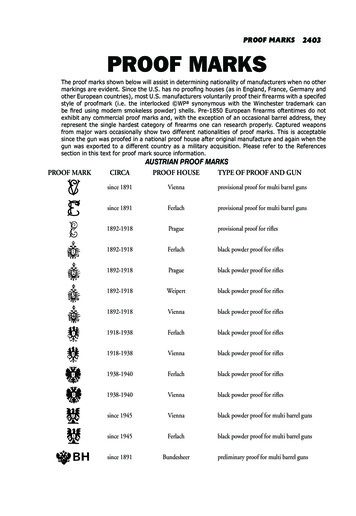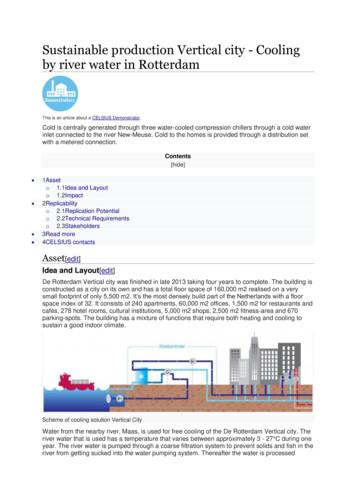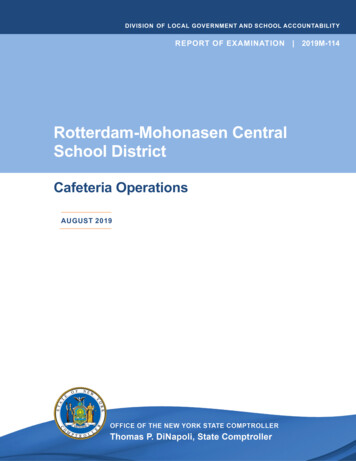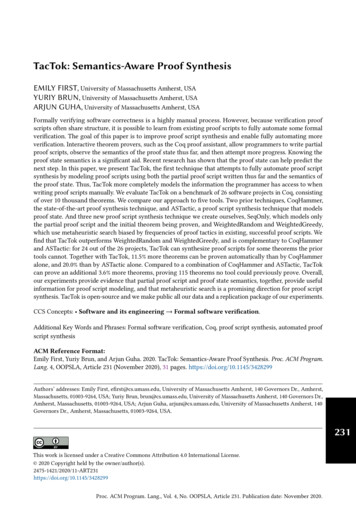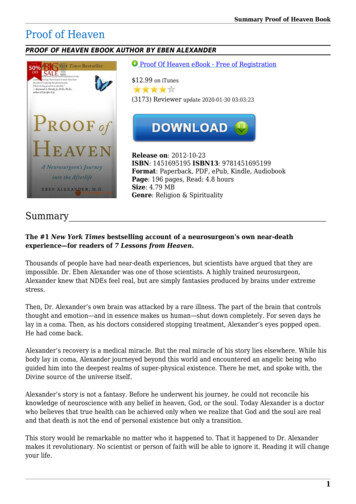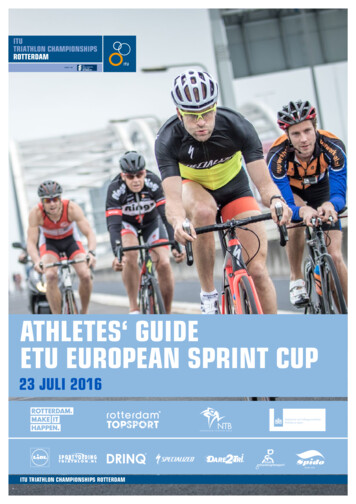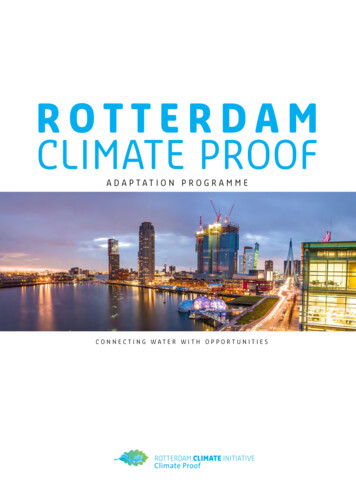
Transcription
ROTTERDAMCLIMATE PROOFADAPTATION PROGRAMMECONNECTING WATER WITH OPPORTUNITIES
Hannah Anthonysz100% CLIMATE PROOF : CONNECTINGWATER WITH OPPORTUNITIESOur climate is changing. The consequences ofclimate change will also be felt in Rotterdam.Rain showers are already becoming heavier,presenting the city with the challenge ofexcess water or flooding. In the long run, ourlow-lying delta city will also be confrontedwith rising sea levels and exceptionally highor low river levels and discharges. Furthermore, the temperature in the city will rise,and heat stress will affect increasing numbers of people. Longer periods of drought arealso to be expected.In order to confront the challenge of climate change as anclimate, including the causes of climate change (mitigation)opportunity rather than a threat, the City of Rotterdam set upas well as the consequences (adaptation).the Rotterdam Climate Proof programme at the end of 2008.Rotterdam Climate Proof will make Rotterdam resilient to cli-THE ROTTERDAM APPROACHmate change by 2025. Permanent protection and accessibilityRotterdam Climate Proof connects water with opportunities.of the Rotterdam region are key elements. Rotterdam is oneClimate adaptation and spatial development are inextrica-of the safest port cities in the world. Rotterdam has started tobly intertwined in Rotterdam. This approach allows urbanadapt in order to strengthen its position. The central focus ofplanners to create new designs that effectively address thethe adaptation programme is to create extra opportunities toissue of climate change. At the same time, the necessity ofmake Rotterdam a more attractive city in which to live, work,investing in climate adaptation will create and sustain therelax and invest.momentum needed to enhance the city’s attractiveness.Adaptation to climate change is more than just a necessityTrendsetting research, innovative knowledge development andfor Rotterdam. Perhaps even more importantly, it offers ana dynamic and decisive implementation of the suggested mea-economic opportunity. This approach is characteristic ofsures will result in strong economic incentives. Rotterdam is anRotterdam Climate Proof. Gaining knowledge and experienceinspiring example to other (delta) cities around the world.fast in combining water management, spatial planning andother innovative techniques will allow the corporate sector toRotterdam Climate Proof participates in the Rotterdam Cli-build a powerful competitive advantage.mate Initiative. Thus, Rotterdam addresses the entire issue ofR OTTE R D AM C LI MATE PROOF -2- AD APTATION PR OGR AM M E
PROGRAMME BASED ON THREE PILLARSstrong economy for the residential and business communi-The Rotterdam Climate Proof programme is based on threeties. Innovations and knowledge are developed and applied inpillars: knowledge, actions and marketing communications.practice in Rotterdam. The Stadshavens (City ports) district, inEnsuring that Rotterdam will be climate proof in every res-particular, will be the recipient of substantial investments, forpect by 2025 is the common goal. Innovative solutions willinstance in terms of adaptive building and floating construc-enhance the safety and the quality of life in the city, while attions (such as the floating pavilion), the Netherlands Waterthe same time offering substantial economic potential for theCentre and Clean Tech Delta. This will help Stadshavens toentire region.become Rotterdam’s showcase for ‘urban delta technology’.1. KNOWLEDGE3. EXPOSURE AND SPIN-OFFTrendsetting research in the area of theoretical and appliedRotterdam positions itself as a delta city with an internatio-delta technology enables Rotterdam to create the basis fornal port and a city which approaches future climate changegroundbreaking innovations and international collaboration.in an unpretentious, safe and innovative manner. Not onlyWithin the Dutch national research programme entitledon a local level but also on a national and international‘Knowledge for Climate’, Rotterdam has been named a hot-level, Rotterdam projects an aura of innovation, reliability,spot in this field. Most of the knowledge projects are includedand decisiveness. In 2010, Rotterdam was represented atin this programme. Knowledge development also takes placethe World Expo 2010 to show the world how this metropo-through knowledge exchange. For this reason, Rotterdamlis manages to keep the city and port safe from flooding,has set up the international knowledge network called ‘Con-despite climate change. Establishing international knowledgenecting Delta Cities’. In addition, Rotterdam cooperates in-agreements and partnerships, Rotterdam has a prominenttensively with the Rotterdam University for Applied Sciencesposition among the leaders in the field. These leaders in the(water management), Erasmus University Rotterdam (EUR)international field of water management and delta issues metand regional knowledge partners such as TU Delft, Unesco-each other during the conference ‘Deltas in Times of ClimateIHE and Deltares.Change’, which took place in Rotterdam in 2010. In 2014(24 – 26 September), a second international conference will2. CONCRETE RESULTSbe organized together with the national research programmeInvesting in a climate proof city contributes to the realization‘Knowledge for Climate’ and the Ministry of Infrastructureof a safe, healthy, and attractive living environment and aand the Environment of the Netherlands.By investing in green infrastructure at street level and on roofs, providing more space for water to run off, such as using the river Meuse as a tidalpark, water safety and water nuisance issues will be linked to new urban development which will actively improve the city’s attractivenessR OTTE R D AM C LI MATE PROOF -3- AD APTATION PR OGR AM M E
Eric FeckenROTTERDAM’SADAPTATIONSTRATEGYRotterdam’s Adaptation Strategy addressesthe urgent need to make Rotterdam climateproof by describing which guidelines needto be in place to effect this over the next fewdecades, in as targeted and effective wayas possible. The strategy is not an implementation plan, but provides a framework,establishes starting points and clarifies Rot-The central focus of the adaptation programme is to create extraterdam’s ambitions and goals to become aopportunities to make Rotterdam a more attractive city in which toresilient city.live, work, relax and investThe Adaptation Strategy’s knowledge base is made upenhancing the adaptiveness of public spaces - for example byof research that has been carried out in recent years, forinvesting in green infrastructure at street level and on roofs,example within the scope of the Knowledge for Climate re-providing more space for water to run off, such as water pla-search programme and the Delta Programme (to protect thezas, or using the river Meuse as a tidal park - water safety andNetherlands against flooding and to ensure supplies of freshwater nuisance issues will be linked to new urban developmentwater now and in the future) in which Rotterdam activelywhich will actively improve the city’s attractiveness. Floatingparticipates.developments not only result in new and inviting areas toThe climate effects acknowledged in the strategy consist of ex-live and work in, but also in innovations that strengthen thetremes in river levels, the rising level of the sea, the increase ofcity’s economy. Developments in the unembanked areas willcloudbursts, longer periods of drought and higher temperatures.be based on the multilayer safety approach, consisting of aThe following objectives have been set and are to be metcombination of prevention, spatial adaptation and disasterthrough the Adaptation Strategy:management. In addition, the strategy aims to raise the awa-1. The city and the port are protected against flooding.reness of Rotterdam citizens and businesses and actively invol-2. Rotterdam is a comfortable, liveable and attractive city toves them in helping to increase water safety and dealing withreside in.water-related inconvenience and urban heat stress effects.3. Rotterdam is an accessible port city facing minimal risk ofdisruption.Adaptation to climate change is a long-term affair. However,4. The city and its residents are affected as little asRotterdam cannot afford to wait any longer, as the city ispossible by a lack or surplus of precipitation.continuously changing and is in a constant process of develop-5. The residents of Rotterdam are aware of the consequencesment. The adaptation strategy will be incorporated in plan-of climate change and of what they can do themselves toning processes and maintance programmes. Rotterdam wantsadapt to them.to support the implementation and to monitor the progress6. Climate adaptation strengthens the city economically andby means of suitable tools and instruments. A number ofenhances its strong delta city image.instruments have already been developed, like the RotterdamClimate Societal Cost Benefit Analysis and the RotterdamRobustness, resilience and awareness are the key elementsClimate Game; others will be developed in consultation withof the Rotterdam Adaptation Strategy. The Maeslantkeringthe respective stakeholders and implementation partners, bothstorm surge barrier, the dikes and the sewage system needwithin and outside the City of Rotterdam.to be ready to carry out their tasks. Dikes may become greenconnections in the city, or multifunctional water barriers. ByR OTTE R D AM C LI MATE PROOF -4- AD APTATION PR OGR AM M E
ROTTERDAM CLIMATE PROOFPROGRAMME RESULTSRotterdam Climate Proof started out at the endof 2008 and is currently in full swing as part ofthe Rotterdam Climate Initiative. In the meantime, the following results have been achieved:KNOWLEDGE Rotterdam Adaptation Strategy fully developed and updated in 2013 Rotterdam Climate Societal Cost Benefit Analysis (SCBA)and Rotterdam Climate game completed (2012) All research projects under the national research programme Knowledge for Climate/tranche 1 have been completed:oUrban development - Urban water systemsoFlood risk in unembanked areasoClosable-but-open Rhine estuaryoRegion-specific climate information for Haaglandenand RotterdamoHeat stress in the city of RotterdamoConsequences of climate change for inland shippingoAdaptive strategies for the urban floodplain of HotspotRotterdam Start of Knowledge for Climate research tranche 2 and 3Publication ‘Research Summaries Rotterdam’s ClimateAdaptation’ (2010) International design contest ‘Delta City of the Future’ inRotterdam has over 130,000 m2 of Green RoofsRotterdam (2010) Publication ‘Deltas in Times of Climate Change’ (2010) In 2010 over 1200 international politicians, scientists, Start of international conference ‘Deltas in Times of ClimateChange II’ from 24 – 26 September 2014 in Rotterdampolicy makers, practitioners and entrepreneurs visited Book I ‘Connecting Delta Cities’ (2009)the international conference ‘Deltas in Times of Climate Book II ‘Climate Adaptation and Flood Risk in CoastalCities’ (2010)Change I’ in Rotterdam Book III ‘Adaptation strategies in delta cities’ (to bepublished in 2014)International conference ‘Deltas in Times of Climate Change’IMPLEMENTATION Rotterdam has over 130,000 m2 of Green Roofs (2013) Start of Nassauhaven floating house developments (2013) Underground water storage at Kruisplein car park of2300 m3 (2013) Multifunctional water plaza Benthemplein (internationalshowcase) will be completed by the end of 2013 Levee at Hilledijk area expanded to super levee includingcity park (2013) Start of climate proof city pilots for Feijenoord andHeijplaat districts (2012)R OTTE R D AM C LI MATE PROOF -5- AD APTATION PR OGR AM M E
Water plaza at Bellamyplein completed (2012) Participation in a regional knowledge valorisationprogramme for delta technology (2012) Underground water storage under Museumpark car park(10,000 m3) in operation (2011) Water plaza Kleinpolderplein (2011)List of possible locations for floating communities inRotterdam completed (2011) Floating pavilion in Rotterdam Rijnhaven completed (2010) Green wall (5000 m2) at Westblaak car park (2010) 5000 m3 of additional water storage space in Tjalklaan (2010) Design and agreement for Blue Corridor, construction started(2009) Participation in regional delta programme RijnmondDrechtsteden under the chairmanship of the mayor ofRotterdam, Mr Ahmed Aboutaleb (2009)Water plaza at Bellamyplein completed in 2012 The Ecorys study shows that making Rotterdam climate proofwill result in an investment of 4 to 5 billion euros (2010) Over 825,000 people plus dozens of delegations visitedthe pavilion ‘Rotterdam Water City’ at the World ExpoShanghai 2010 Start of curriculum and collaboration with Watermanagement at Hogeschool Rotterdam (2009) Connecting Delta Cities network set up within C40 (2008) Over one hundred presentations all over the world More than a hundred international delegations visitedRotterdam Hundreds of (international) publications about RotterdamClimate ProofCooperation with the City of Rotterdam has allowed Ho Chi Minh City todevelop its own climate adaptation strategyIn 2010, Rotterdam was represented at the World Expo 2010 toshow the world how this metropolis manages to keep the city andport safe from flooding, despite climate changeEXPOSURE AND SPIN-OFF Cooperation with the City of Rotterdam has allowedHo Chi Minh City to develop its own climate adaptationstrategy (2013) Expansion of Connecting Delta Cities: New Orleans(2010), Ho Chi Minh City (2011), Melbourne (2011) andCopenhagen (2013) Delta City Rotterdam App (2013) New Orleans: integrated water management plan withhelp of Rotterdam experts (2012) Rotterdam selected as Peer City by the European Commission (2012) in the EU Cities Adapt project Netherlands Water Centre Exposition opened in the floating pavilion (2012)R OTTE R D AM C LI MATE PROOF -6- AD APTATION PR OGR AM M E
INSPIRING EXAMPLESROTTERDAM CLIMATE SOCIETAL COST BENEFITANALYSIS (SCBA) The Rotterdam Climate SCBA wasmate Change. The objective of the ‘EU Cities Adapt’ projectdeveloped as part of the Rotterdam Adaptation Strategy byof becoming climate proof and to support them in developingthe Rebel Group. An SCBA assesses the costs and benefits ofan adaptation strategy. Fifteen cities, divided into threean investment from the point of view of society as a whole.groups, participate in the training programme. For eachTo be able to properly value the benefits, the full effect of aof the groups, two peer cities will counsel the other cities.project needs to be defined. This involves comparing two dif-Together with Ancona, Rotterdam counsels the following fiveferent scenarios, as it were: one scenario showing what thecities: Almada (Portugal), Barcelona (Spain), Burgas (Bulga-world would look like if the project was not implemented (theria), Gibraltar (United Kingdom) and Zadar (Croatia).training programme is to make cities aware of the necessity‘zero’ alternative), and one showing the results if the projectwas implemented (the ‘project’ alternative). The differenceWATER PLAZAS: DOUBLING AS WATER STORAGEbetween these two scenarios is the effect the project wouldRotterdam has an interesting innovation to provide additi-have on society. What makes this SCBA special is that, foronal water storage in a densely built-up city: water plazas.the very first time, an urban climate adaptation model hasMost of the time, these water plazas will serve as marvellousbeen constructed that does not look at just the effects ofplaygrounds or sports fields. Light or medium rain showersa single project, but takes a whole range of measures intowill not cause the plaza to fill up. Rainwater is pumped awayconsideration and employs a dynamic calculation modeland discharged to the sewers, washing away the dust inused for strategic planning. Adaptation measures which arethe streets at the same time. As soon as the intensity of theincorporated in projects at an early stage show a positiveshowers increases, the pressure on the small pump becomesSCBA outcome.too heavy to process the water. The excess water, which isnow cleaner as the dust has been washed away by the firstEUROPEAN COMMISSION DESIGNATES ROTTERDAMAS AN INTERNATIONAL EXAMPLE In the autumn offlush, will reach an overflow point that will divert it to the2012, the Directorate-General for Climate Action – part ofdynamic urban pond. Once the flush is over and the moatsthe European Commission – awarded Rotterdam the title ofreturn to their normal levels, the water plaza can be emptied‘peer city’ in the realm of climate adaptation. Being designa-through a pipe that connects to the deepest point in theted a ‘peer city’ means that Rotterdam has a leading role inplaza, so that it will discharge into the moat gradually.Thethe European Commission’s training programme. The Com-water plaza is a Rotterdam invention, devised by ‘DE URBA-mission has launched an EU Strategy on Adaptation to Cli-NISTEN’ and ‘Studio Marco Vermeulen’.plaza, passing a purification filter on its way. This creates a‘DE URBANISTEN’Water plazas improves the quality of the urban area and at the same time serves as a water storage facilityR OTTE R D AM C LI MATE PROOF -7- AD APTATION PR OGR AM M E
FLOATING PAVILION The floating pavilion in RotterdamCONNECTING DELTA CITIES Over 50% of the worldis remarkable not only because of the spheres floating on thepopulation lives in cities. More than two thirds of the world’swater, but also because of its climate-proof, innovative, sus-largest cities are vulnerable to rising sea levels as a result oftainable and flexible qualities. The floating pavilion, designedclimate change. Millions of people are being exposed to theby Deltasync, is a pilot and a catalyst for floating com-risk of extreme floods and storms. This is the reason whymunities in Rotterdam. As the water level rises, the floatingthe City of Rotterdam founded the Connecting Delta Citiespavilion will automatically rise accordingly. The pavilion isknowledge network, part of the climate leaderschip group C40,thus an example of a climate-proof building, a technology forin 2009. Connecting Delta Cities combines the knowledge,which demand will strongly grow in Rotterdam. The level ofexperiences and connections of Rotterdam, Tokyo, Jakarta,sustainability of the pavilion is determined by the materialsHong Kong, New York, New Orleans, London, Ho Chi Minhused, its flexibility, as well as its fittings. For instance, theCity, Melbourne, Copenhagen and others.building’s heating and air conditioning systems rely on solarenergy and surface water. It contains various climatic zones;WILLEM ALEXANDER ROWING COURSE In 2013 thethe energy is used only in places where it is required at anyWillem Alexander rowing course, part of the new recreationspecific moment. As far as power is concerned, the pavilionarea Eendragtspolder, opened. The rowing course and thewill largely be self-sufficient.Eendragtspolder area also form a large water storage basin.The basin is able to store four million cubic metres of water,ROTTERDAM CLIMATE GAME This game – sponsored bywhich can prevent the river Rotte from overflowing in timesthe Rotterdam Climate Proof programme, the National Newof heavy rainfall. In short, this area combines sport, recrea-Urban Developments and Restructuring Delta Programme andtion, nature and water storage.the Water Governance Centre – makes players aware of thedilemmas involved in climate-proof construction/restructuringFOR MORE INFORMATION, SEE:and spatial developments, both inside and outside the networkwww.rotterdamclimateinitiative.nlof dikes. Players can experiment with a realistic representa-www.deltacities.comtion of the Rotterdam Feijenoord district. While playing game, they will also start to become aware of the multilayersafety approach. In addition, measures can be weighedagainst one another. Considerations of budget and the possibility of applying for a grant are also part of the game. Thegame was developed by Tygron Serious Gaming.The climate-proof floating pavilion is a pilot and a catalyst for the ambitious plans of Rotterdam for the construction of floating communitiesR OTTE R D AM C LI MATE PROOF -8- AD APTATION PR OGR AM M E
international field of water management and delta issues met each other during the conference 'Deltas in Times of Climate Change', which took place in Rotterdam in 2010. In 2014 (24 - 26 September), a second international conference will be organized together with the national research programme
